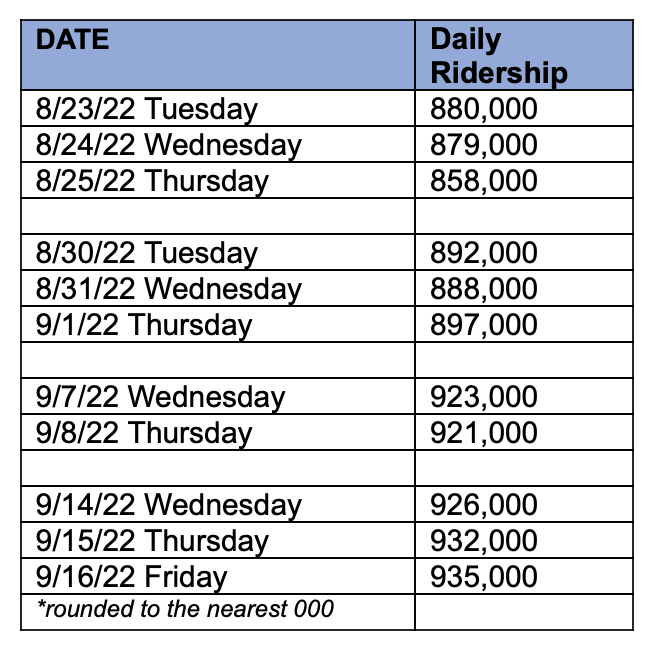The CTA has been under a lot of heat lately, and rightly so. While service gaps caused by COVID-19 related staffing shortages are somewhat understandable, customers are fed up with unpredictable waits for buses and trains, and Transit Tracker arrival times that often have no basis in reality. That frustration was evident in the I'm Late protest in front of the transit agency's headquarters on September 14, which drew about 60 demonstrators. Adding insult to injury, later that day CTA president Dorval Carter Jr. failed to show up for a City Council hearing on poor service, which further annoyed advocates and alderpersons.
So the CTA could clearly use some good news to help change the narrative. Today the agency provided that in the form of encouraging bus and rail ridership numbers. The figures show more people have been using the system recently than at any time before the pandemic reached Chicago in March 2020. According to the CTA, the weekday ridership average has been breaking 900,000 trips, compared to about 1.6 million journeys in pre-pandemic times. Moreover, downtown ridership has doubled as people have been returning to offices and other activities in the central city.
The CTA says that each of the last four weeks has broken the previously weekly ridership record for the pandemic. The number of trips the week starting on Monday, September 12, was up 10 percent from the same time in 2021, with over 5.5 million rides. Bus ridership was up 8 percent compared to the previous year, while rail ridership increased by 13 percent.
“Transit is vital to our region as we recover from a long pandemic that upended our daily normal," said Carter in a statement. It was perhaps his first public comment since he angered City Council members, and got bad press in all major local news outlets, by ghosting his own hearing on "ghost" runs.
Here's one weird trick for transit agency presidents who want to get bad press in every local media outlet: Skip your own City Council hearing on poor service.https://t.co/4xIVU4v59jhttps://t.co/9OFCtFwYrDhttps://t.co/hIIQOuOWGYhttps://t.co/QcvDOY8vmOhttps://t.co/LBR5grbrTz pic.twitter.com/GTB67nBK71
— John Greenfield (@greenfieldjohn) September 15, 2022
"The recent ridership peaks are an important barometer of our crucial role in providing affordable and green transportation to all. The fall season is typically our highest ridership period for the year, and in 2022, that tradition continues. As more riders return to transit, our top focus is providing the most reliable, consistent service possible."
Here are the ridership peaks from the last four weeks:
Last January, when the Omicron variant was a major concern, the system only averaged around 540,000 rides on weekdays and about 14.3 million rides for the whole month, according to the CTA. So the current weekly numbers – over 900,000 a day on weekdays and 22.3 million trips for all of September – are dramatically higher.
Downtown weekday 'L' ridership spiked by 21 percent compared to 2021, with over 100,000 average weekday rides provided during the week starting September 12, up from an average of only 38,000 on weekdays in January of 2021, the agency said. Both morning and evening rush hour ridership continues to recover, with downtown peak hour ridership up roughly 34 percent between Tuesday and Thursday.
In addition to more downtown activity, school attendance is contributing to ridership gains, according to the CTA. K-12 student ridership averaged 68,000 daily trips on weekdays during the week of September 12, an increase of 6 percent in comparison to the same week in 2021. College students enrolled in the U-Pass also returned to the system in large numbers, with average weekday ridership reaching 65,000. That's a 16 percent increase over the same time last year.
So there's reason to be optimistic about the CTA getting back on it's feet. The troubling question is, will it be able to do so before federal COVID subsidies run out and, if not, what then? Read more on that topic here.






